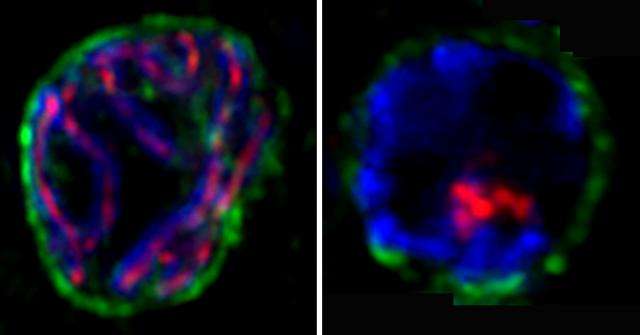Biologists identify reproductive 'traffic cop'

Before an egg becomes fertilized, sets of chromosomes must pair up to pass along genetic information. This happens within each reproductive cell, where separate chromosomes of male and female origin move toward each other and eventually join.
University of Iowa biologists have discovered a protein that appears to regulate the speed at which the female (maternal) and male (paternal) chromosome strands move and pair up. In laboratory tests, the researchers learned the protein acts like a brake on the chromosomes' movement, especially the juncture at which the chromosomes join and share DNA, which is critical to an offspring's successful inheritance of its parents' genes.
The findings offer new insight into the intricate steps involved in animal fertility, from basic organisms all the way to humans. They also could help biologists better understand defects that occur in reproduction, including those that contribute to Down syndrome.
The research was published online this month in The Journal of Cell Biology.
"To our knowledge, this is the first study to show the importance of negative regulation of chromosome movement...and pairing between homologous chromosomes," writes Sarit Smolikove, associate professor in biology and the paper's corresponding author. "This indicates that precise control of chromosome movement is imperative for the success of these processes."
The researchers identified a protein in nematodes (a type of worm intensively studied by scientists) called FKB-6, which acts much like a traffic cop. FKB-6 instructs another protein, dynein, which by moving along filaments connected to each chromosome helps the pair journey toward each other. When the chromosome strands have joined, FKB-6 acts as a brake on dynein, slowing the process and ensuring the uninterrupted sharing of DNA.
"Chromosomes' movement is important because you need to move them in synchronicity," Smolikove says. "We've shown you don't want to move them too much or too frequently. You need to give the strands time to join for cell division to be done correctly."
Smolikove likens the process to a parent zipping a coat for a child. If the child is jerking about as the parent tries to zip the coat, it takes longer for the action to be completed; worse, the zipper could break, meaning the coat doesn't get zipped at all. Likewise, the chromosome strands need to line up and have the time to "zip up," so genetic information is accurately swapped.
"There should be a balance between moving and stopping," Smolikove says, "and FKB-6 is the one that regulates those actions."
The researchers screened some 200 proteins connected to meiosis (reproductive-cell division) in nematodes as they tried to determine which ones were most involved in chromosome movement, especially at the fusing stage. They determined FKB-6's role when they canceled its function, causing the chromosome pairing to go somewhat haywire: The mutant chromosomes paused less, changed directions more, and traveled greater distances than ones with the FKB-6 protein.
Moreover, cells in worms without FKB-6 failed to properly perform mitosis (a later stage in reproduction when a cell forms two new nuclei with the same number of chromosomes as the parent nucleus), causing a high proportion of embryo defects, the researchers found.
Humans have a similar protein, FKBP52, which also is closely involved with stabilizing the filaments that connect chromosomes. Further testing would be needed to more precisely establish FKBP52's role in human reproduction.
More information: Benjamin Alleva et al, Regulating chromosomal movement by the cochaperone FKB-6 ensures timely pairing and synapsis, The Journal of Cell Biology (2017). DOI: 10.1083/jcb.201606126
Journal information: Journal of Cell Biology
Provided by University of Iowa
















